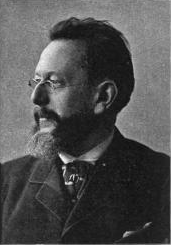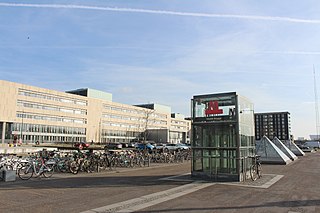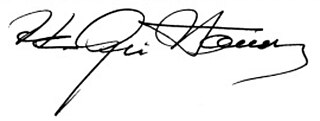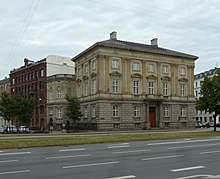
The Royal Swedish Academy of Sciences is one of the royal academies of Sweden. Founded on 2 June 1739, it is an independent, non-governmental scientific organization that takes special responsibility for promoting natural sciences and mathematics and strengthening their influence in society, whilst endeavouring to promote the exchange of ideas between various disciplines.
A national academy is an organizational body, usually operating with state financial support and approval, that co-ordinates scholarly research activities and standards for academic disciplines, and serve as public policy advisors, research institutes, think tanks, and public administration consultants for governments or on issues of public importance, most frequently in the sciences but also in the humanities. Typically the country's learned societies in individual disciplines will liaise with or be coordinated by the national academy. National academies play an important organisational role in academic exchanges and collaborations between countries.
The Norwegian Academy for Language and Literature, commonly known as the Norwegian Academy, is a Norwegian learned body on matters pertaining to the modern Norwegian language in its Dano-Norwegian variety, now commonly known as Riksmål and Bokmål. The academy was established in the Norwegian government's honorary residence Grotten in 1953 based on the model of the Swedish Academy and the French Academy, but the idea was originally conceived by Bjørn Bjørnson in 1913. Its members are elected for life on the basis of scholarly, literary or artistic merits. The academy publishes the main dictionary of Norwegian, Det Norske Akademis ordbok, is responsible for regulating the written standard known as Riksmål and has a literary and cultural purpose. The academy awards the Norwegian Academy Prize in memory of Thorleif Dahl.

Wilhelm Ferdinand Bendz was a Danish painter mainly known for genre works and portraits which often portray his artist colleagues and their daily lives. He was one of the most talented artists in the successful generation of painters who studied under Christoffer Wilhelm Eckersberg but died early and has therefore left a relatively small oeuvre.

The Royal Danish Academy of Sciences and Letters is a Danish academy of science. The Royal Danish Academy was established on November 13, 1742, and was created with the purpose of strengthening the position of Science in Denmark as well as promoting interdisciplinary understanding.

The Norwegian Academy of Science and Letters is a learned society based in Oslo, Norway. Its purpose is to support the advancement of science and scholarship in Norway.

Henrik Mohn was a Norwegian astronomer and meteorologist. Although he enrolled in theology studies after finishing school, he is credited with founding meteorological research in Norway, being a professor at the Royal Frederick University and director of the Norwegian Meteorological Institute from 1866 to 1913.
Magne Skodvin was a Norwegian educator and historian.

The Royal School of Library and Information Science is a school under the University of Copenhagen that provides higher education in the field of library and information science. It has now merged with another department to Department of Communication. It is based in Copenhagen, Denmark. It is a member of iSchools, a consortium directed to understanding the role of information in nature and human culture. There has also been a location in Aalborg, however this campus was shut down in the summer of 2017.
Danish television dramas have come to represent an important and popular aspect of TV broadcasting in Denmark, especially since the 1970s.
Events from the year 1742 in Denmark.

The Centre for Advanced Study at the Norwegian Academy of Science and Letters is an independent research foundation funded by the Norwegian Ministry of Education and Research. CAS is located in Oslo, Norway.

Henrik Julius Ager-Hanssen was a Norwegian nuclear physicist and businessperson. He spent his career in the nuclear energy sector from 1956 to 1975, then in the petroleum company Statoil from 1976 to 1998.
The Junge Akademie at the Berlin-Brandenburg Academy of Sciences and Humanities (BBAW) and the German National Academy of Sciences Leopoldina is supported by the two oldest scientific academies in Germany, and represents an interdisciplinary platform for up-and-coming academics. Its membership comprises fifty young academics and artists from a broad range of disciplines. All hail from the German-speaking countries and are committed to interdisciplinary discourse. Each year sees ten new members elected for a period of five years. The Junge Akademie was founded in 2000 as the world's first national institution for the promotion of young academics. Numerous countries have since used it as a model for the establishment of their own national academies for young academics.

Julius Henrik Lange was a Danish art historian and critic.
The Reumert Award is an annual Danish awards ceremony to recognize excellence in theatre achievements in Denmark. The award was founded by the Bikuben Foundation in 1998, and has been handed annually since then. There are 16 award categories as well as 10 talent awards. A jury of ten specialists in theatre selects the recipients, who receive a statuette and a prize. As of 2016, the recipients also receive an amount of money. The recipients of the Reumert Award of Honour receive DKK 200,000, the recipients of the Talent Prize receive DKK 35,000 and all other categories-recipients receive DKK 40,000. The Reumert prize is named after the Danish actor Poul Reumert (1883–1968).
Jayne Christine Svenungsson (1973) is a Swedish theologian and philosopher who holds the chair in Systematic Theology at Lund University. Her field of research lies within political theology, aesthetics and the philosophy of history.
Else Marie Friis is a Danish botanist and paleontologist. She is Professor Emerita in the Department of Geoscience at Aarhus University. Her work has been fundamental in the phylogenetic analysis of angiosperms, with widespread application to reproductive biology.

Rebecca Adler-Nissen is a Danish political scientist specializing in international politics, particularly in European integration and the European Union, as well as the relationship between EU and its member states. She is a professor in the department of political science at the University of Copenhagen.

A Meeting in the Royal Danish Academy of Sciences and Letters is a monumental 1897 oil-on-canvas group portrait painting by Peder Severin Krøyer, depicting the membership of Royal Danish Academy of Sciences and Letters during one of its meetings in the Prince's Mansion in Copenhagen. The painting was commissioned by the Carlsberg Foundation in conjunction with the construction of its new building on H. C. Andersens Boulevard. Measuring 519.4 cm (204.5 in) wide and 266.7 cm (105.0 in) tall, it is Krøyer's largest painting.











